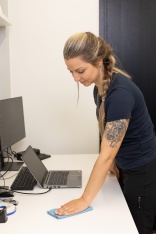Home › magazine › web article › latest news › How did the ergonomics project come about?
How did the ergonomics project come about?
13th of January 2025For three years a team of industry experts has been gathering material on cleaning ergonomics and conscious cleaning. And asking the question: are we forgetting the core objective of cleaning, which is achieving cleanliness? Does the outcome of cleaning support building users’ and cleaners’ health, or is it detrimental to it?
Helge Alt from Puhastusekspert in Estonia and Tarja Valkosalo of Propuhtaus Finland have been involved since the start of the project. In the first of a series of articles for ECJ, they tell us how it all came about.
In 2020, we launched the Cleaning Handbook in Estonia. We started to look for the latest perspectives on cleaning ergonomics, working through a range of materials and data. We realised that this is a serious issue, affecting the lives and health of many people. The health effects are often felt many years later and are difficult to attribute to specific cleaning activities.
For example, in Finland cleaners were absent from work due to illness for an average of 19 days in 2023, compared to an average of 11 days for all occupations. This is 73 per cent more than the average. Musculoskeletal disorders are a common cause of sickness absence and cleaners are more likely than usual to take disability pension due to mental health problems.
In the European Union, more than four million people are employed as cleaners. If the situation is similar in other countries, then the EU is expected to have 76 million days of sick leave per year for cleaning workers.
Eighty-nine per cent of cleaning companies have fewer than 50 employees and lack the capacity to deal with ergonomics in depth themselves. For them, the material created in the project framework will be of great help.
So the idea was born to bring together cleaning professionals from different countries and to start researching the issue, writing a project and creating materials that are accessible to all, thanks to the support of Erasmus+.
During the project:
• We carried out an international survey, to which 267 cleaners and 147 cleaning managers responded.
• We carried out Smartwear tests in Finland to find out more precisely which parts of the body can be affected by which jobs, and how they are done.
• We analysed cleaning ergonomics materials available in the world.
• We tested the training materials we developed with cleaning workers.
Key findings:
• Ninety-three per cent of the cleaners who responded to the survey felt pain in some part of their body when working.
• In the context of ergonomics, we must look at the mental impact as well as the physical damage. Seventy-two per cent of cleaning supervisors and 46 per cent of cleaning workers experienced mental strain at work, 43 per cent of cleaning supervisors and 69 per cent of cleaning workers experienced physically demanding tasks.
• The amount of load is individual and depends, among other things, on age and the muscular condition of the individual.
• According to the Smartwear studies - regardless of the subject - the load of moist and wet mopping can be more than double that of a scrubber dryer
The project resulted in:
• 20 educational videos and pictorial guides on common occupational accidents and diseases
• Training material for teaching cleaning ergonomics.
Cleaning can be good for your health, but it can also be harmful. It all depends on HOW you clean, it depends on knowledge and skills. According to ESG principles, the S(ocial) factor is concerned with people's wellbeing and cleaning ergonomics is relevant here.
On the project website you will find unique materials on cleaning ergonomics - https://ergoclean.eu/










